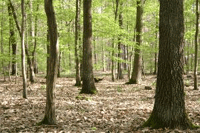Reactive nitrogen in forest soils yield greenhouse gases
21 Apr 2011
Reactive nitrogen compounds from agriculture, transport, and industry lead to increased emissions of the greenhouse gas nitrous oxide (N2O) from forests in Europe. Nitrous oxide emission from forest soils is at least twice as high as estimated so far by the Intergovernmental Panel on Climate Change (IPCC).
 |
| Forest soils emit climate-damaging nitrous oxide. The causes are reactive nitrogen compounds from industry and agriculture. (Photo:KIT) |
This is one of the key messages of the first study on nitrogen in Europe (European Nitrogen Assessment, ENA) presented this week at the International Conference, ''Nitrogen and Global Change 2011,'' in Edinburgh, Scotland.
Reactive nitrogen compounds (eg NH3 and NOx) are mainly of anthropogenic origin. After their deposition to forests via air, they are partly converted into nitrous oxide (N2O). Following carbon dioxide and methane, nitrous oxide is the third most important greenhouse gas. One kilogramme of nitrous oxide is about 300 times as greenhouse-effective as the same amount of carbon dioxide.
The ENA study performed by more than 200 scientific and political experts from 21 countries and 89 organisations concludes that the consequences of reactive nitrogen from air in the European forests so far has been underestimated significantly. Based on the information now available, about 2 to 6% of the atmospheric reactive nitrogen is converted into nitrous oxide that is emitted from forest soil into the atmosphere again. The corresponding estimate of the IPCC so far was about 1% only.
Over a forest area of 188 million hectares, deposition of reactive nitrogen increased from 1860 to 2000 by 1.5 million tons per year. This corresponds to an increase in reactive nitrogen per hectare forest by about 8 kilogrammes.
The increased atmospheric input of reactive nitrogen mainly comes from fertiliser use in agriculture and the associated volatilisation of ammonia and from nitrogen oxide emissions due to the combustion of fossil fuels or biomass burning.
Increased deposition of reactive nitrogen to forests does not only result in climate-damaging nitrous oxide emissions from forest soils, but also in a loss of diversity of plant and animal species and enhanced nitrate emissions into water.
When presenting this part of the ENA study in Edinburgh, Professor Klaus Butterbach-Bahl emphasised: ''The present atmospheric reactive nitrogen deposition is much too high. Our analysis shows that significant reductions in particular of ammonia emissions from agricultural activities are needed to reduce nitrous gas emissions from forest
soils.''
Klaus Butterbach-Bahl is professor at Karlsruhe Institute of Technol-ogy (KIT). He is heading the Atmospheric Environmental Research Division of the Institute of Meteorology and Climate Research (IMK-IFU) and lead author of the ENA chapter 19 on reactive nitrogen as a threat to the European greenhouse balance.













.jpg)






.jpg)









